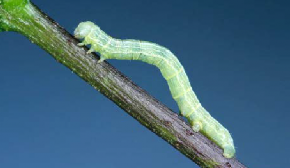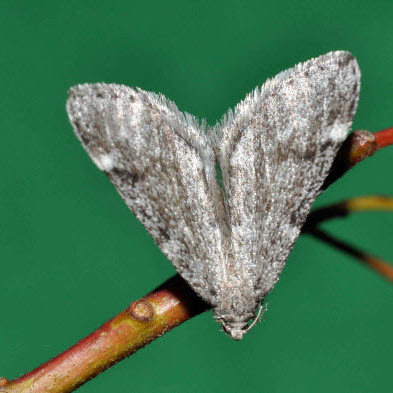Fall Cankerworm: Bustle in the Fall, Party in the Spring
by Kathleen Curthoys, Fairfax Master Gardener
 A type of moth that emerges in the fall gets busy making a hungry new generation that can devour your spring greenery like teenagers at a tailgate party.
A type of moth that emerges in the fall gets busy making a hungry new generation that can devour your spring greenery like teenagers at a tailgate party.
The native Fall Cankerworm (Alsophila pometaria) moths appear from the ground in wooded areas as adults in October and November. The moths mate, then the females climb broadleaf trees to lay their eggs in masses that overwinter on branches. The masses appear in neat rows of as many as 100 eggs from each female. From a distance, the egg masses can resemble patches of scaly bark.
In April and May, the newly hatched larvae find a brunch buffet in the landscape and they dig into the buds and new leaves. Small holes appear at first. Then the larvae can eat right down to the leaf ribs and veins. Still hungry, they can shoot out silky strands that swing them on the wind to other trees.
The defoliation can go on until mid-summer, when the Fall Cankerworm caterpillars drop to the ground and get ready for the fall, spending the pupal stage inside cocoons spun of silky threads and soil.

Fall cankerworm damage
These insects may prefer oak trees, which are known to be suffering “oak decline” from a variety of factors, as well as maple, ash, hickory and many other hardwoods.
The Fall Cankerworm is a clear and present danger in Fairfax County and across Northern Virginia, where “moderate to high populations” of Fall Cankerworms have persisted in urban areas since the 1990s, according to Virginia Cooperative Extension.

Fall cankerworm moth
The adult moths that appear in the fall are brownish/silvery gray. Female moths are wingless, about ½ inch long and may look like spiders with their prominent front legs. Male moths have glossy wings with white bands and a wingspan of about 1 inch.
Eggs are less than 1 mm in diameter but are visible in masses on tree branches where they appear to be disc-shaped. The brownish-grayish eggs have a ring circling the edge and a dark mark on the top.
Larvae in the spring may be light green with white lines along their bodies, or dark brownish-green with a black stripe running down their backs. At about 1 inch long, they “inch” forward on three pairs of legs that have a gap after the first pair of legs. You can tell the Fall Cankerworm larvae from the similar Spring Cankerworm larvae (Paleacrita vernata): the Spring Cankerworm has only two pairs of legs.
What do you do about these cankerworms?
If you suspect your trees have Fall Cankerworms, you can take action now. During the fall, you can impede the female moths on their way up the landscape trees by “banding” the trees with a sticky band wrapped around the trunk. But if the moths are infesting other trees nearby, they may still reach the branches of the trees you are trying to protect.
In the spring, you may get a break from cool, wet weather, which keeps the Fall Cankerworm population down. In any case, watch out for the larvae and signs they are feeding on your trees.
The Fall Cankerworm has some natural enemies, including the Telenomus alsophilae wasp, which preys on the eggs, and Calosoma frigidum, a ground beetle that will eat the larvae. They help keep the Fall Cankerworm population down, but there still may be outbreaks of infestation.
If there is a significant infestation, an option is to use a registered insecticide and follow recommendations in the Home Grounds and Animals Pest Management Guide for homeowners. As always, adhere to the label directions carefully.
Early in the spring, when larvae are beginning to appear on the leaves, a biological pesticide, Bacillus thurgingiensis var. kurstaki (Btk), can be sprayed to control the larvae before they binge on your delectable shade trees.
Resources
Fall Cankerworm, Virginia Cooperative Extension publication ENTO-223NP (ENTO-404NP)
Fall Cankerworm, Gregory A. Hoover and Timothy R. Haydt, Penn State Extension
Fall Cankerworm, Fairfax County Public Works and Environmental Services
2023 Home Grounds and Animals Pest Management Guide, (VCE Publication) p. 4–44, Table 4.6